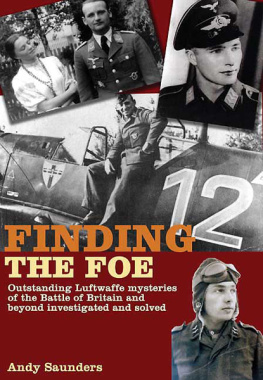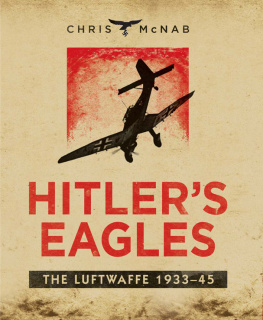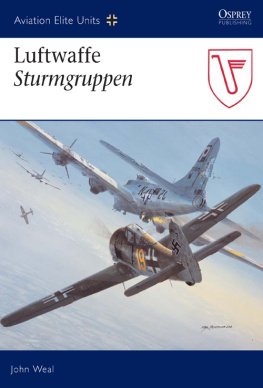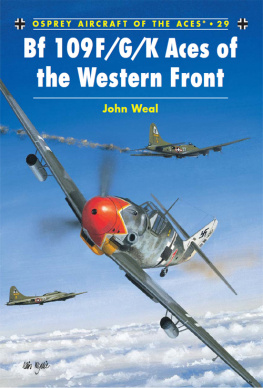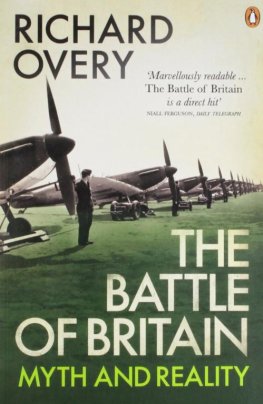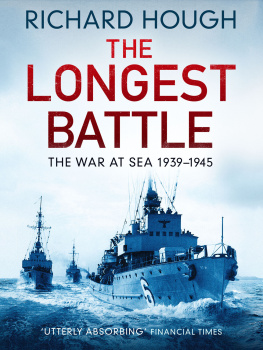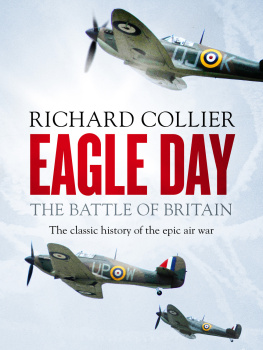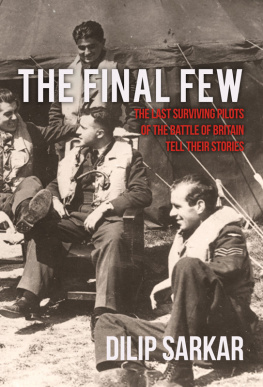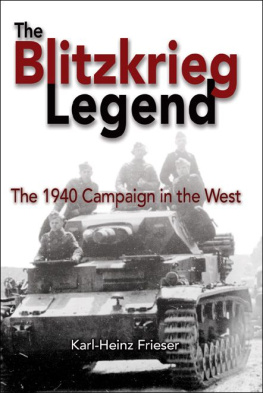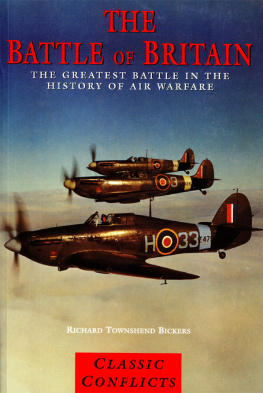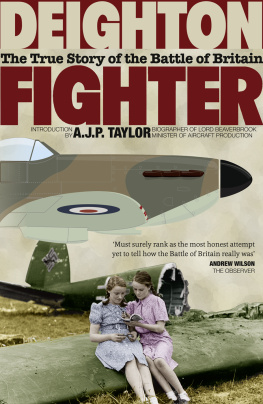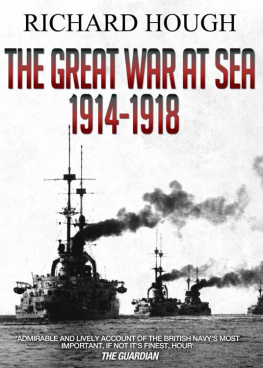THE
BATTLE OF
BRITAIN
THE
BATTLE OF
BRITAIN
THE JUBILEE HISTORY
RICHARD HOUGH
AND
DENIS RICHARDS

First published in Great Britain in 1989 and 1990 by Hodder and Stoughton
Re-printed in this format in 2007
PEN & SWORD AVIATION
an imprint of
Pen & Sword Books Ltd
47 Church Street
Barnsley
South Yorkshire
S70 2AS
Copyright Richard Hough and Denis Richards, 1989, 1990, 2007
ISBN 978 1 84415 6 573
The right of Richard Hough and Denis Richards to be identified
as authors of this work has been asserted by him in accordance
with the Copyright, Designs and Patents Act 1988.
A CIP catalogue record for this book is
available from the British Library
All rights reserved. No part of this book may be reproduced
or transmitted in any form or by any means, electronic or mechanical
including photocopying, recording or by any information storage and
retrieval system, without permission from the Publisher in writing.
Printed and bound in Great Britain
By Biddies
Pen & Sword Books Ltd incorporates the imprints of
Pen & Sword Aviation, Pen & Sword Maritime, Pen & Sword Military,
Wharncliffe Local History, Pen & Sword Select,
Pen & Sword Military Classics and Leo Cooper.
For a complete list of Pen & Sword titles please contact
PEN & SWORD BOOKS LIMITED
47 Church Street, Barnsley, South Yorkshire, S70 2AS, England
E-mail: enquiries@pen-and-sword.co.uk
Website: www.pen-and-sword.co.uk
COLOUR PICTURES
BLACK AND WHITE PICTURES
Between pages 206 and 207
MAPS
LINE ILLUSTRATIONS
Careless Talk Costs Lives
Front page of the Daily Telegraph, 16 September 1940
Abbreviations and Code-Names
Used in Text
| AA | Anti-aircraft |
| AAF | Auxiliary Air Force |
| AASF | Advanced Air Striking Force |
| AC2 | Aircraftman 2nd Class |
| Adlerangriff | Eagle Attack: German air offensive against Britain |
| Adlertag | Eagle Day: first day of Adlerangriff |
| AI | Air Interception: airborne radar |
| AMES | Air Ministry Experimental Station: radar station |
| AOC | Air Officer Commanding |
| AOC-in-C | Air Officer Commanding-in-Chief |
| ARP | Air-Raid Precautions |
| BE | British Experimental - early aircraft |
| BEF | British Expeditionary Force |
| CAS | Chief of the Air Staff |
| CH | Chain Home: standard radar stations |
| CHL | Chain Home Low: low-reading radar stations |
| CO | Commanding Officer |
| Cromwell | Code-name to bring British forces to highest degree of readiness, September 1940 |
| DF | Direction Finding |
| Do | Dornier |
| Dynamo | Code-name for evacuation from Dunkirk |
| Enigma | German encoding machine |
| Erpro | Erprobungsgruppe |
| G, Geschwader | = RAF Group |
| GCI | Ground Controlled Interception: ground radar used in conjunction with AI |
| Gr, Gruppe | = RAF wing |
| He | Heinkel |
| HF | High frequency radio |
| IFF | Identification Friend or Foe - device to identify British aircraft |
| JG, Jagdgeschwader | Fighter group |
| Ju | Junkers |
| KG, Kampfgeschwader | Bomber group |
| Knickebein | Crooked leg: wireless beam system for navigation |
| LAC | Leading Aircraftman |
| LDV | Local Defence Volunteers later Home Guard |
| Me | Messerschmitt |
| MT | Mechanical transport |
| OKW | Oberkommando der Wehrmacht High Command of the German Armed Forces |
| Ops room | Operations room |
| OTU | Operational Training Unit |
| PAC | Parachute and Cable defence device for airfields, etc. |
| RDF | Radio Direction Finding British name (till 1943) for radar |
| R/T | Radio telephony |
| Seeloewe | Sealion: code-name for projected German invasion operation |
| Sigint | Intelligence derived from signals |
| Staffel | = RAF squadron - 9 aircraft |
| StG, Sturzkampfgeschwader | Dive-bomber group |
| Stuka | Dive-bomber (Ju 87) |
| Ultra | Highest grade of secrecy - decrypts of messages encoded on the Enigma machine |
| Vector | Compass bearing |
| Vics | V formations |
| WAAF | Womens Auxiliary Air Force |
| W/T | Wireless telegraphy |
| VHF | Very high frequency radio |
| Y | Listening or interception service, W/T and R/T |
| ZG, Zerstoerergesckwader | Destroyer (Me no) group |
F ifty years on is a good moment for reappraising, and where appropriate celebrating, any great event. Sufficient time has elapsed for it to be seen in historical perspective; nearly all the preserved documentation is usually available; and there are enough of the participants still alive to furnish detail and informed criticism.
There are two further reasons which apply especially in the case of the Battle of Britain. The first is that the passing years have only confirmed, what was hoped and thought at the time, that the Battle was one of the great turning-points in World War II a defensive victory which saved the island base and so, once Russia and the United States became involved, made future offensive victories possible. The second reason is that within these fifty years fresh generations have been born to whom much of the story is unfamiliar. There are indeed already many excellent books concerned with the Battle which they might read with profit, but as many of these are personal memoirs, or relate to particular episodes, or are intended mainly for the scholar or aficionado, it seemed to us that there was still a place for a new narrative intended for the general reader.
There are two points of emphasis within the book which may need explanation. The British victory resulted primarily from the fact that when the German threat materialised, there were the means to deal with it. How the RAF managed to survive at all in the 1920s, how an efficient air defence system was created over the years, how modern fighters were developed and brought into service, and how the strength of Fighter Command was painfully built up and preserved amid many competing claims, are therefore a substantial part of our story.
Similarly there is a perhaps unusual concentration within the Battle itself on seven of the sixteen weeks for which it officially lasted. The official duration, decided by the Air Ministry after the war, was based on the operations as seen from the British side and was promulgated primarily to define the limits within which aircrew would qualify for the Battle of Britain clasp. Nothing else would explain the choice of a sheer calendar date, 31 October, as the termination. But it seems to us that in as much as invasion was the proposed next step if the Luftwaffe succeeded, the heart and soul of the Battle was very much the period between the Eagle attacks in the second week of August and the closing days of September, by which time Hitler had postponed the invasion indefinitely and the British had sensed the relaxation of his preparations. We have accordingly treated these vital weeks in considerably greater detail than the fighting of July and October.
Next page

